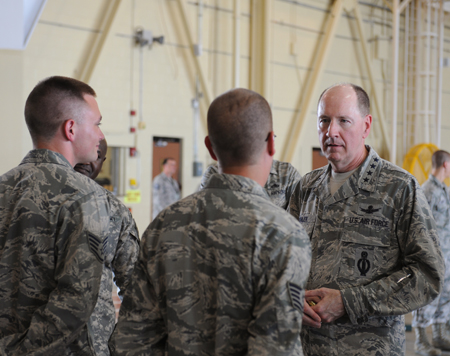 Thus far, budget sequestration has not affected the day-to-day readiness of the units operating the nation’s nuclear triad or executing other critical US Strategic Command activities in space and cyberspace, said Gen Robert Kehler, STRATCOM commander, on Wednesday. That’s because the services have given “preferential treatment” to supporting those missions, Kehler told defense reporters in Washington, D.C. However, the services will not be able to sustain this practice the longer the sequester lingers, leaving the specter of a readiness crisis on the horizon that would not leave STRATCOM’s missions unscathed, he said. “I am worried about readiness. It is like watching an avalanche where you see it start small and if you continue to ignore readiness accounts, the momentum builds and eventually you have a big readiness avalanche,” he said. The human dimension of this, such as the furlough of Defense Department civilian personnel due to the sequester, “has gotten lost” in the budget debates, said Kehler. “I am very worried that those [civilians] who are near retirement age will not hang on with us because they will not be confident in us,” he said. Similarly, some civilian new hires already have come to their supervisors and said: “I don’t think I am going to stay because I don’t see the future here,” said Kehler during the July 24 meeting.
Thus far, budget sequestration has not affected the day-to-day readiness of the units operating the nation’s nuclear triad or executing other critical US Strategic Command activities in space and cyberspace, said Gen Robert Kehler, STRATCOM commander, on Wednesday. That’s because the services have given “preferential treatment” to supporting those missions, Kehler told defense reporters in Washington, D.C. However, the services will not be able to sustain this practice the longer the sequester lingers, leaving the specter of a readiness crisis on the horizon that would not leave STRATCOM’s missions unscathed, he said. “I am worried about readiness. It is like watching an avalanche where you see it start small and if you continue to ignore readiness accounts, the momentum builds and eventually you have a big readiness avalanche,” he said. The human dimension of this, such as the furlough of Defense Department civilian personnel due to the sequester, “has gotten lost” in the budget debates, said Kehler. “I am very worried that those [civilians] who are near retirement age will not hang on with us because they will not be confident in us,” he said. Similarly, some civilian new hires already have come to their supervisors and said: “I don’t think I am going to stay because I don’t see the future here,” said Kehler during the July 24 meeting.
While the Space Force is still making long-term plans to establish high-fidelity live and virtual test and training ranges in the coming years, officials say they're also working with operators to identify near-term gaps and quickly field capabilities to address them.

